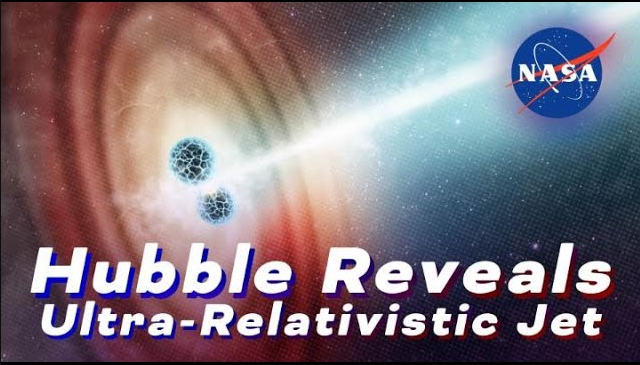Hubble Discovers Extremely Rapid Jet Blasting From Star Crash
It has been determined by astronomers using NASA’s Hubble Space Telescope that the epic collision between two neutron stars was the source of a jet that was traveling faster than 99.97% the speed of light.
In August 2017, the explosive event known as GW170817 was noticed. A supernova explosion’s worth of energy was unleashed by the explosion. It was the first instance where gravitational waves and gamma radiation from the merging of two neutron stars were both detected.
Even though the event occurred in 2017, it has taken scientists some time to figure out how to examine the Hubble data as well as data from other telescopes to create this whole image.
For extremely long baseline interferometry, the Hubble observation was paired with data from several National Science Foundation radio telescopes (VLBI). The radio data was collected 230 and 75 days following the event.
Kunal P. Mooley of Caltech in Pasadena, California, who is the lead author of a paper that will be published in the journal of Nature magazine on October 13 said, “I’m amazed that Hubble could give us such a precise measurement, which rivals the precision achieved by powerful radio VLBI telescopes spread across the globe.”
To attain extraordinary precision, the authors combined Hubble data with information from the Gaia satellite operated by the European Space Agency (ESA) and VLBI. According to Jay Anderson of the Space Telescope Science Institute in Baltimore, Maryland, “It required months of meticulous study of the data to make this assessment.”

Credits: Artwork: Elizabeth Wheatley (STScI)
To attain extraordinary precision, the authors combined Hubble data with information from the Gaia satellite operated by the European Space Agency (ESA) and VLBI. According to Jay Anderson of the Space Telescope Science Institute in Baltimore, Maryland, “It required months of meticulous study of the data to make this assessment.”
They were able to locate the explosion place by integrating the various observations. According to the Hubble measurement, the jet was traveling at a speed that was seven times the speed of light. The jet eventually decelerated to an apparent speed that was four times faster than the speed of light, according to the radio measurements.
Since nothing can move faster than light in reality, this so-called “superluminal” velocity is a delusion. The light that the jet emits subsequently needs to travel a shorter distance since it is moving toward Earth at a speed that is almost equal to the speed of light. The jet is essentially chasing its own light. The spectator may not realize that additional time has passed between the jet’s light emissions. This leads to an overestimation of the object’s velocity, which in this case seems to be more than the speed of light.
Wenbin Lu of the University of California, Berkeley stated that “our data shows that the jet was flying at least at 99.97% the speed of light when it was launched.”
The long-supposed link between neutron star mergers and short-duration gamma-ray bursts is further strengthened by the Hubble findings in combination with the VLBI results, which were reported in 2018. The fast-moving jet that is needed for that link to form has now been observed in GW170817.
This discovery paves the path for more accurate investigations of neutron star mergers, which were discovered by the gravitational wave observatories KAGRA, Virgo, and LIGO. Relativistic jet observations might open up a new avenue of research in the future years for determining the Hubble constant, which is a measure of how quickly the universe is expanding.
One of the major puzzles in modern astronomy is the gap between Hubble constant values calculated for the early cosmos and the nearby universe. The varying estimates are supported by incredibly accurate observations of Type Ia supernovae made by Hubble and other observatories, as well as measurements of the cosmic microwave background made by the ESA’s Planck spacecraft. Astronomers attempting to answer the riddle could benefit from additional perspectives on relativistic jets.
NASA and ESA collaborated internationally on the Hubble Space Telescope project. The telescope is run by NASA’s Goddard Space Flight Center in Greenbelt, Maryland. Hubble science operations are carried out by the Space Telescope Science Institute (STScI) in Baltimore, Maryland. The Association of Universities for Research in Astronomy, based in Washington, D.C., runs STScI for NASA.
Do not forget to share your opinion with us to provide you with the best posts !




0 Comments